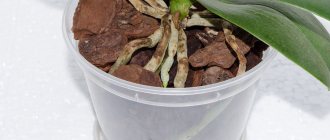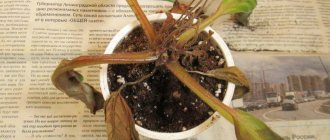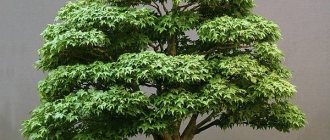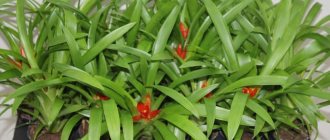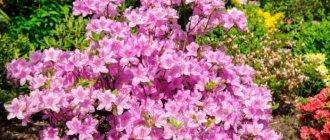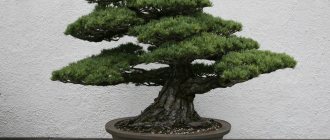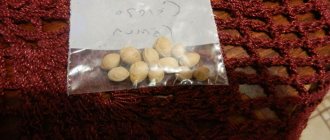Sakura impresses with its exquisite and uniquely delicate blossoms. In East Asia, the Japanese cherry tree is a national symbol that is protected by law. During its flowering, a holiday is held where everyone worships the fabulous tree.
Under natural conditions, the plant reaches several meters. Many people grow miniature copies. Sakura bonsai is an exact copy of an adult plant, reduced many times. It is worth noting that bonsai is a national culture of growing trees in a bowl.
Description of the plant
Sakura bonsai is an ornamental tree that does not require special care conditions. The plant is resistant to the dryness of city apartments, indoor gas pollution, watering and lighting.
Japanese cherry has become a favorite among gardeners due to its amazing flowering. Inflorescences with a diameter of 1 cm tightly frame the branches, creating a monochromatic cloud.
In nature, sakura blooms with bright pink flowers. Breeders have tried and artificially bred plants with a variety of shades.
How to grow a tree from seeds
Sakura bonsai, like other plants, can be grown by seed. True, this process is very difficult and very troublesome. Since bonsai takes 15-20 years to form, homemade sakura will require a lot of patience.
Where to buy sakura seeds and how to grow a flowering plant at home is of interest to many beginners and amateurs. After all, sakura is a plant with amazing flowering, and its formation in the form of a tree on a tray will be the most exciting activity.
Japanese cherry seeds are purchased at specialized garden centers, although they appear there very rarely.
Advice! If you find sakura seeds, you should stock up on planting material, since they sprout “infrequently and sparsely.” According to the observations of professionals, out of 10 seeds, only 1-2 germinate, that is, the germination percentage is 10-20%.
There is a technology for growing sakura from seeds at home:
- After purchasing, each seed should be scarified (pricked, filed), since their shell is very durable.
- Place in warm water for 24 hours to swell.
- After this - into moist soil to a depth of no more than 2 cm.
- Cover the pot with film and place in a cool place (bottom shelf of the refrigerator, cellar). The stratification period is 60-70 days.
- After the “cooling” period has expired, the pot is placed in a bright place and kept at room temperature.
- When seedlings appear, young specimens should be immediately transplanted into special bonsai pots - flat pots. When picking in groups, the distance between young plants should not be more than 10 cm.
Important! The sakura plant has many varieties, each of which has special characteristics and requirements for cultivation. That is why, when purchasing seeds, it is recommended to study what kind of soil, watering and fertilizing regime a particular variety of Japanese cherry prefers.
Sakura seeds are sown in April-May. The soil used is a mixture of coarse sand, sphagnum moss, and vermiculite. The first sprouts appear within 2 weeks after moving the flowerpots to heat.
The incomparable blossoming of sakura, photos of which are presented on the Internet, pleases the eye much earlier than the appearance of leaves and other flowers in the garden. As a rule, already in April-May the tree is densely covered with flowers up to 1 cm in diameter. The month of cherry blossoms depends on the climatic conditions of the region and the plant variety. Unfortunately, the flowering does not last long, but the beautiful pink cloud is replaced by noble greenery. And Sakura again captivates with its appearance.
How to plant potted sakura is recommended by professionals. Despite the variety of the species, young plants need picking. In addition, seedlings are replanted every 3-4 years as they grow (replantation is not performed in winter - the plant is dormant).
Growing sakura seedlings
Not all varieties are suitable for growing in open ground under our climatic conditions. The choice is limited exclusively to frost-resistant ones.
- Kanzan (small-serrated cherry) - up to 10 m high, crown diameter - up to 8 m. A profusely flowering tree with densely double bright pink flowers that open in May.
- Kmku-Shidare (weeping cherry), the height reaches 8 m, the diameter of the irregular crown is up to 4 m. The irregularity of the crown is associated with flexible, drooping shoots. It blooms at the end of March and produces edible fruits.
For planting, it is preferable to buy seedlings in the fall, when the trees have shed their leaves. One-year-olds take root more easily; their height is usually 65-75 cm.
Roots and branches are carefully examined:
- dry shoots should be absent;
- there should be no wounds;
- roots without swelling or rot.
The seedlings are stored in a cool basement or veranda until spring, placed in a pot or bucket. Planted in open ground in spring.
It is preferable to plant Japanese beauty on a gentle slope (slope up to 10°) in a southwestern direction. If the area is flat, choose a place so that the tree is evenly illuminated by the sun and protected from the wind.
Do not plant sakura in strictly southern directions - temperature changes are more noticeable there, and sakura has a hard time surviving them. They are also not suitable for planting in lowlands where the tree may freeze.
The soil needed is neutral (some varieties prefer slightly acidic or slightly alkaline), loamy, and does not retain moisture.
The landing algorithm is as follows.
- A planting hole with a diameter of 45 cm is prepared in advance.
- The upper fertile layer is poured separately from the lower one, which is not needed.
- The top layer of soil is mixed with compost or humus in equal volumes.
- The bottom of the hole is laid out with a 10-centimeter drainage layer - pebbles, expanded clay, crushed stone.
- Pour in 2/3 of the prepared soil mixture, forming a small mound in the center.
- The seedling is lowered into the hole, making sure that the root collar remains at ground level.
- Add the remaining soil, tamp it down, and water it.
- After the soil settles, add a new portion: the seedling will take root faster if there is no air left between the roots.
Simultaneously with planting, a support is installed. After planting, the tree is tied up. Dig a groove 10 cm deep around the circumference and fill it with water.
Picking
Plant picking is extremely important for the development of a tree. The first picking should be carried out immediately after germination. Small seedlings are planted in 100 ml cups. The substrate is made up of 7 parts turf soil, 3 parts sand (disinfection and roasting in the oven are mandatory) and 1 part humus. During the first pick, the root is shortened by 1/3.
The second picking of plants is carried out after 2 months. During the period of work, the root is pinched by 2/3 and the plant is slightly buried. The soil used is of the same composition.
The third pick is carried out after the sakura grows. But not more often than 2 months after the second procedure. It is recommended to repot the plant when the plant to pot height ratio is 2:1.
How to plant and pick sakura at home
Proper planting is half the success of future sakura growing:
- treat the seeds with a fungicide;
- moisten the substrate;
- deepen the seeds half a centimeter into the grooves made (there should be at least 3 cm between them);
- cover the planting with a thin layer of fine-grained sand;
- cover the pot with film or glass;
- leave at a temperature of +5…10 °C.
Attention! Gardeners recommend planting seeds in the spring or at the turn of August and September.
Seedlings should appear in 1.5-2 weeks. Until this point, care consists of keeping the top layer of soil moist, providing plenty of light, and gradually raising the temperature to room temperature. When shoots appear, plant them in separate pots. The distance between seeded seedlings should not be more than 10 cm if you move them to a new common container.
Bonsai care rules
There is very little information about sakura: what kind of tree is it, how to care for it? Those who were lucky enough to grow a blooming beauty from seeds say: indoor sakura is very difficult to care for and requires daily attention. Although seed sellers claim its unpretentiousness.
Competent tips on how to care for sakura at home include:
- Organization of the watering regime: in summer the tree is watered with 100-125 ml of water per day, in winter watering is reduced.
- Creating a sufficient amount of light: bonsai pots are kept in the brightest rooms, but without drafts or direct sunlight.
- Annual replanting with shortening of the root system: the plant is grown in a bowl with a diameter of 15-20 cm.
- Soil preparation in accordance with the requirements of a particular variety: sakura loves nutritious soil with a high content of nitrogen, humus, and potassium.
Important! Organic fertilizers are applied to the soil a month before replanting the plant, that is, the soil for sakura is prepared in advance. Mineral fertilizers are added during the transplantation period.
When growing a tree in the bonsai style, you should also worry about the formation of the crown. The trunk of a young plant is fixed with wire, and characteristic bends are created if necessary. When the plant rises 20-30 cm, the main trunk is cut off. This promotes the formation of side shoots.
Bonsai is a miniature tree that requires constant pruning. The side shoots are pruned after flowering, shaping the direction of the branches.
Important! A simple way to control the growth of a bonsai is to make a series of horizontal cuts in the tree bark. Mechanical damage leads to weakening of the tree and stops its development. But this should be done extremely carefully.
Currently, there are a huge number of ways to form a crown. Creation of an individual style begins when the plant is 2-3 years old.
Even with minimal care and the creation of optimal conditions, the plant will delight you with its flowering every year.
Diseases and pests: prevention and treatment
Even if you follow all the rules for caring for a tree, it is not a fact that it will not get sick or be invaded by pests, since recreating ideal conditions for development in the middle zone is very problematic and many factors do not depend on you. Therefore, we will next talk about how to deal with diseases and pests of sakura.
Let's start with the fungal disease coccomycosis. The disease is also called reddish-brown spot and is quite dangerous for the tree.
Signs: spots corresponding to the second name, appearing on the leaves in early summer, the appearance of gray sporozoans on the back of the leaf.
Consequences: growth inhibition and decreased immunity, as well as decreased frost resistance.
Reasons: damp, warm, windy weather, as well as a large number of rotting fallen leaves.
Control: use specialized fungicides that will rid the tree of fungus in several approaches.
Prevention: removing leaves outside the site or burning; digging the soil in early spring; preventive treatment with drugs (if there is a chance of infection).
Important! Spraying sakura during flowering is prohibited. Aphid
A well-known parasite that will not leave any plant in the garden alone. Aphids are carried by ants and can also travel through the air
Aphid. A well-known parasite that will not leave any plant in the garden alone. Aphids are carried by ants and can also travel through the air.
A large colony not only violates the integrity of the bark, but also draws out a lot of sap, which is especially dangerous for young trees. As a result, growth and development are inhibited, and wounds on the bark become an excellent entry point for pathogenic microorganisms. Wintering also becomes problematic. You can prevent the appearance of aphids by coating the trunk with medical Vaseline, or by applying double-sided tape. However, if the aphids move through the air, then only insecticide treatment will save you.
This concludes our discussion of an incredibly beautiful tree. After reading the article, you learned how and how long sakura blooms, what kind of species it is, and how to grow it in your garden. Try to spend more time on the tree in the early stages in order to notice and eliminate the problem in time.


